Charging a car battery at 2 amps or 10 amps will determine the duration and considerations needed. When charging a car battery, the choice between using 2 amps or 10 amps will affect the duration of the charging process and the factors to be considered.
Charging at 2 amps provides a slow and gradual charge that is gentler on the battery, taking longer to reach a full charge. On the other hand, charging at 10 amps delivers a faster charge but with more heat, which may decrease the battery’s lifespan.
Considerations such as the battery’s condition, the charger’s capabilities, and time constraints should be taken into account when deciding on the appropriate charging amperage. Ultimately, the chosen amperage should provide an optimal balance between charging time and battery health.
Understanding Car Battery Charging
When it comes to car battery charging, it’s important to understand the different methods and considerations involved. One particular aspect to pay attention to is the charging rate, which is typically measured in amps. In this section, we will explore the charging methods and the importance of proper charging for your car battery.
Charging Methods
There are primarily two common charging methods used for car batteries:
- 2 Amps Charging: This method involves charging your car battery at a lower rate of 2 amps, which is considered a slow and steady approach. It is suitable for situations where time is not a constraint, such as overnight charging or when the battery is not severely discharged.
- 10 Amps Charging: This method, on the other hand, involves charging the battery at a higher rate of 10 amps, which is faster than the 2 amps charging method. It is typically used when time is limited or when the battery needs a quick charge.
Both methods have their pros and cons, and the choice between them depends on your specific needs and circumstances.
Importance Of Proper Charging
Proper charging of your car battery is crucial to ensure optimal performance and longevity. Here are a few key considerations:
- Battery Longevity: Charging your battery at the recommended rate helps to preserve its overall lifespan. Overcharging or undercharging can lead to damage and reduce its durability.
- Battery Health: Proper charging prevents sulfation, a process where sulfur crystals form on the battery plates, leading to reduced capacity and performance. The right charging rate helps to minimize this issue and keeps your battery in good health.
- Safe Charging: Following the appropriate charging method ensures safety, as overcharging can cause the battery to overheat, releasing potentially harmful gases. Proper charging also reduces the risk of damage to your vehicle’s electrical system.
- Efficient Charging: Charging at the correct rate ensures optimal efficiency, allowing your battery to reach its full charge potential. This is especially important for batteries with a higher capacity.
- Preserving Other Components: Proper charging helps to preserve other components of your car’s electrical system, such as the alternator, by preventing excessive strain or overheating during the charging process.
By understanding and implementing the appropriate charging method, you can maintain the health and performance of your car battery, ensuring it serves you reliably for years to come.

Credit: www.harborfreight.com
Charging At 2 Amps
When charging a car battery at 2 amps, it’s crucial to understand the duration required and the considerations to ensure optimal battery health.
Duration
Charging a car battery at 2 amps typically takes considerably longer than at higher amperages.
Considerations
- Charging at 2 amps is suitable for long-term maintenance charging to prevent overcharging and to slowly revive deeply discharged batteries.
- This method is gentle on the battery and can be left unattended for longer periods while maintaining battery health.
- However, it might not be suitable for quickly reviving a discharged battery or for regular recharging due to the extended duration.
Charging At 10 Amps
Charging a car battery at 10 Amps can significantly reduce the charging duration compared to 2 Amps. However, it’s essential to consider the battery’s maximum charging capacity and the potential risk of overheating. It’s recommended to consult the vehicle’s manual or a professional for proper charging guidance.
When it comes to charging car batteries, one common option is to charge at a rate of 10 amps. This higher charging rate can offer some advantages over the slower 2 amp charging option, but it’s important to consider the duration and other factors before making a decision.
Duration
Charging a car battery at a rate of 10 amps can significantly reduce the charging time compared to using a 2 amp charger. A 10 amp charger can typically charge a car battery to 80% capacity within 4-6 hours, depending on the battery’s size and condition.
However, it’s important to note that the last 20% of the battery’s capacity takes longer to charge, regardless of the charging rate. This is due to the battery chemistry and is necessary to ensure the battery is properly charged and ready for use.
Considerations
Before opting for the higher 10 amp charging rate, there are a few considerations to keep in mind:
- Battery Condition: Charging at 10 amps may be suitable for most car batteries in good condition. However, if the battery is old, damaged, or experiencing problems, it’s recommended to consult the manufacturer’s guidelines or seek professional advice.
- Heat Generation: The charging process can generate heat, especially when using a higher charging rate. It’s important to monitor the battery’s temperature and ensure it doesn’t exceed recommended levels. Excessive heat can damage the battery and reduce its lifespan.
- Battery Capacity: Different car batteries have varying capacities. Charging a larger capacity battery at 10 amps will take longer compared to a smaller capacity battery. It’s essential to consider the battery’s capacity and choose an appropriate charging rate accordingly.
- Charger Compatibility: Not all chargers are compatible with a 10 amp charging rate. It’s crucial to check the specifications of the charger to ensure it can handle the higher ampere output. Using an incompatible charger can damage the battery or the charger itself.
In conclusion, charging a car battery at 10 amps can be a convenient option, reducing the charging time compared to a slower rate. However, it’s important to consider the battery’s condition, heat generation, battery capacity, and charger compatibility before deciding on the charging rate. Taking these factors into account will help to ensure optimal battery performance and longevity.

Credit: www.amazon.com
Comparison: 2 Amps Vs 10 Amps
Comparing the charging time and factors to consider for car batteries, using a 10 Amps charger will charge the battery faster compared to a 2 Amps charger. However, it is important to carefully consider the battery type and the potential risk of overcharging before making a choice.
When it comes to charging a car battery, the amperage you choose can make a significant difference. Two of the most common options are charging at 2 amps or 10 amps. Understanding the comparisons between these two options is essential to make an informed decision. In this section, we will compare the charging time, battery health, and safety considerations for both charging rates.
Charging Time
The charging time is a crucial factor to consider when deciding between 2 amps and 10 amps. Charging at 2 amps takes considerably longer compared to 10 amps. At 2 amps, it may take several hours or even overnight to fully charge a car battery. On the other hand, charging at 10 amps significantly reduces the charging time, typically taking around 4-6 hours. If you need a quick charge, opting for 10 amps is the way to go.
Battery Health
Battery health is another vital aspect to keep in mind when choosing the amperage for charging. Charging at 2 amps is typically considered a slow and gentle charge. This slow charging rate is beneficial for maintaining and extending the overall lifespan of the battery. On the other hand, charging at 10 amps can put more stress on the battery, potentially leading to increased wear and tear over time. If preserving the lifespan of your battery is a priority, charging at 2 amps is the recommended option.
Safety
When it comes to safety, both charging rates have their considerations. Charging at 2 amps is generally safer as it produces less heat and reduces the risk of overcharging or damaging the battery. Furthermore, the lower amperage helps prevent accidents or electrical hazards. However, charging at 10 amps can be more convenient, especially when you need a quick charge. It is crucial to consider safety precautions such as monitoring the charging process and ensuring proper ventilation, regardless of the chosen charging rate.

Credit: www.sciencedirect.com
Conclusion
Choosing between 2 amps and 10 amps for charging your car battery depends on your time, safety, and battery condition. It’s important to consider the charging duration and the potential impact on the battery’s longevity. Always adhere to the manufacturer’s guidelines and prioritize safety for optimal performance.


